Where Are Coral Reefs Found?
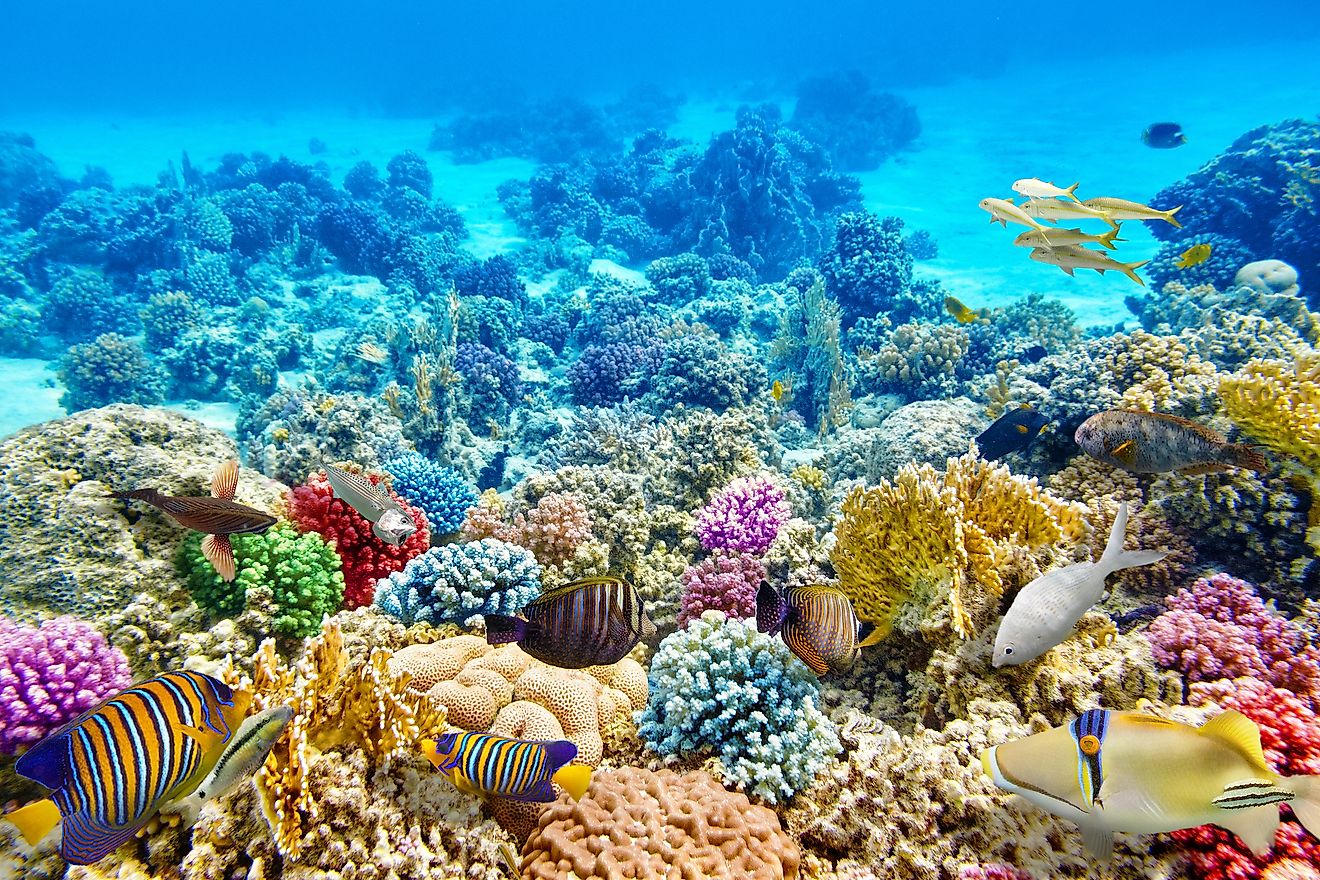
Although seas are important waterways, fishing grounds, and so much more, they also host some of the most diverse ecosystems, including coral reef ecosystems. Coral reefs are underwater ecosystems common in seas and related bodies of water. These reefs are built by coral polyps and can take different forms, including barrier reefs, fringing reefs, atoll, and platform reefs.
As the name suggests, coral reefs are formed when the coral skeletons cluster in groups to form colonies. These coral colonies are held together by calcium carbonate deposits present in the seawater. Most reefs form best in clear, shallow, warm, and agitated waters. Although the first coral reefs appeared over 400 million years ago, most of the existing ones are less than 10,000 years old. The world's coral reefs are of economic importance and are valued at about $10 trillion.
Distribution And Location
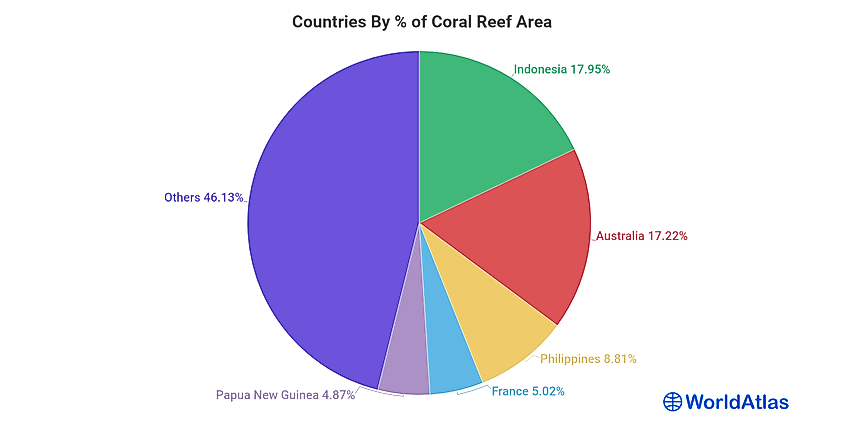
Source: Spalding MD, Ravilious C, Green EP (2001) World Atlas of Coral Reefs. University of California Press, Berkeley, USA.
According to the UNEP World Conservation Monitoring Center, coral reefs cover about 109,800 284,300 km2 or less than 0.1% of the World Ocean's total surface area. The area covered by the reefs is almost the size of Cuba or half the size of France. The largest coral reef area (about 92% of the total area) is within the Indo-Pacific region, a region comprising the Pacific, Indian Ocean, Southeast Asia, and the Red Sea. Of the reefs in the Indo-Pacific, 32.3% are in Southeast Asia, while 40.8% are in the Pacific. The Caribbean and the Atlantic area accounts for about 7.6% of the world’s coral reefs.
The Indian Ocean accounts for up to 60% of the global coastal reefs, the Pacific Ocean 25%, and the West Atlantic 15%. The Hawaiian Island, Madagascar, and the Philippines also have coral reefs. In Southeast Asia, over 70% of the fish are caught on coral reefs. The reefs also support about 25% of marine species in the region.
Although Southeast Asia is the largest reef region, most of the reefs are owned by wealthy nations. About 25% of the world’s coral reefs are shared between France, the US, and Australia. The world’s coral reefs are distributed across 79 countries and regions.
But, which are the largest reef nations? Below are mentioned some of the countries with the largest reef area and threats to the coral reefs in these countries.
Indonesia
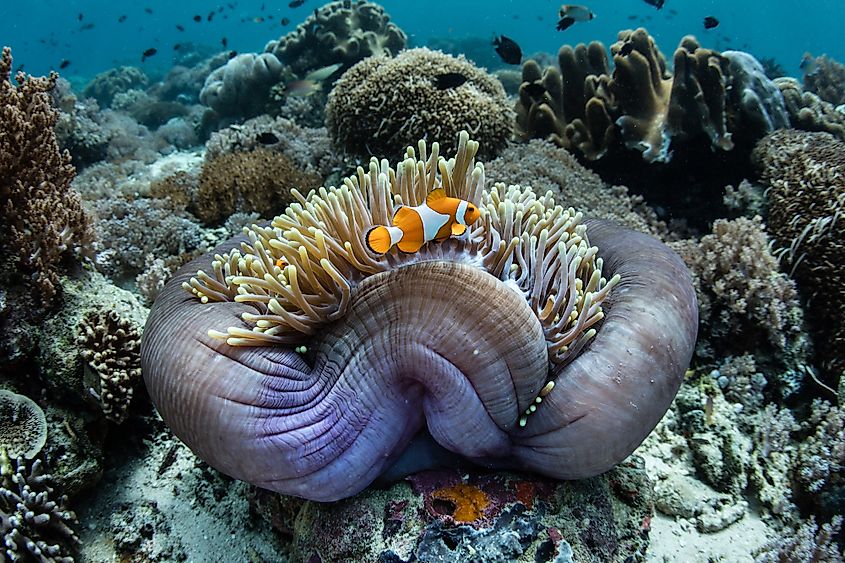
Indonesia consists of over 17,000 islands located between the Pacific and the Indian Ocean. The country has a marine area of approximately 2.9 million km2, with tropical seas surrounding its 80,000 km coastline. These seas host several marine ecosystems, including diverse coral reefs. The tropical marine waters form part of the Coral Triangle that contains over 500 reef-building species. Indonesia is the largest reef nation, with an estimated reef area of 51,020 km2 or 17.95% of the world’s total reef area.
The Indonesian coral reef areas are some of the world’s biologically rich regions. The archipelago is home to over 75% of the coral species, including Scleractinian corals. The country’s coral reefs are evenly distributed from east to west, with the eastern portion having some of the well-developed reefs. In eastern Indonesia, the current flows continuously into the Indian Ocean from the Pacific, making it suitable for reefs to thrive.
Some prominent Indonesian reefs include Takabonerate (the world’s third-largest reef) and Raja Ampat. One of the popular reef complexes is located in the Thousand Islands reef chain, northwest of Jakarta. It consists of 700 reef chains. However, the longest barrier reef system is the Sunda Barrier Reef, which is approximately 630 km long.
About 82% of Indonesia’s reef area is at risk due to several factors, including illegal blast fishing and the large amount of coral export. The country exports up to 500 tons of corals annually.
Australia
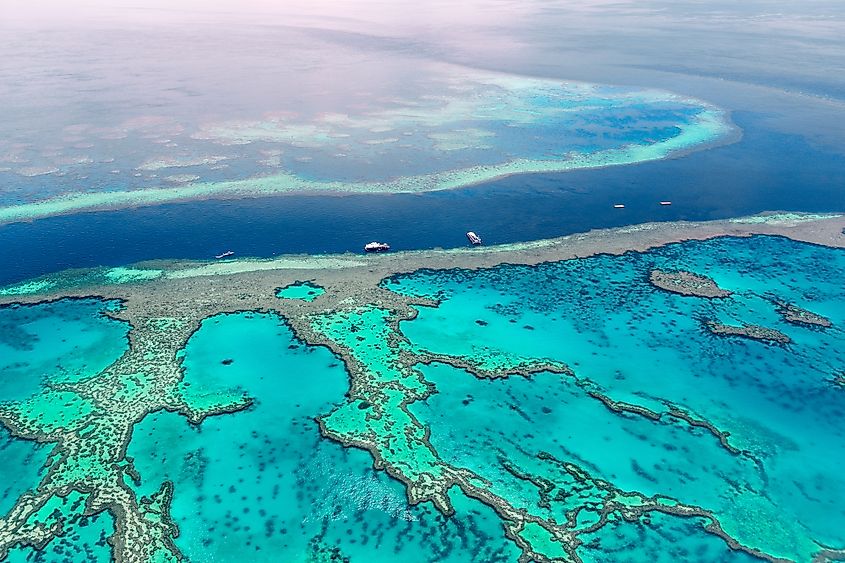
Australia is the second-largest reef nation, with 48,960 km2 of coral reef area, about 2,060 km2s smaller than Indonesia’s reef area. It accounts for 17.22% of the global reef area. Western Australia has numerous reefs of different types along its 3,000 km coastline. Fringing reefs, including Ningaloo (world’s longest reef) and patch reefs, are predominant coral reefs in Western Australia.
Australia is also home to the world’s largest coral reef, the Great Barrier Reef. This reef is located off the Queensland coast and stretches over 2,300 km, covering approximately 344,400 km2. It consists of 900 islands and over 2,900.
Australia also possesses some coral reefs in the Coral Sea, including Lord Howe Island and Elizabeth and Middleton Reefs. Most of the reefs in the Coral Sea are within the Marine Protected Areas.
Primary threats to Australia’s reef system include pollution from mining, pesticides, and sediment runoffs. Mining companies in Queensland often release waste water into the Coral Sea, affecting corals and their reef-building activities. Shipping accidents, such as oil spillage and shipwrecks, especially in the Great Barrier region, have caused significant damage to the coral reefs. Other threats include shark culling and overfishing.
The Philippines
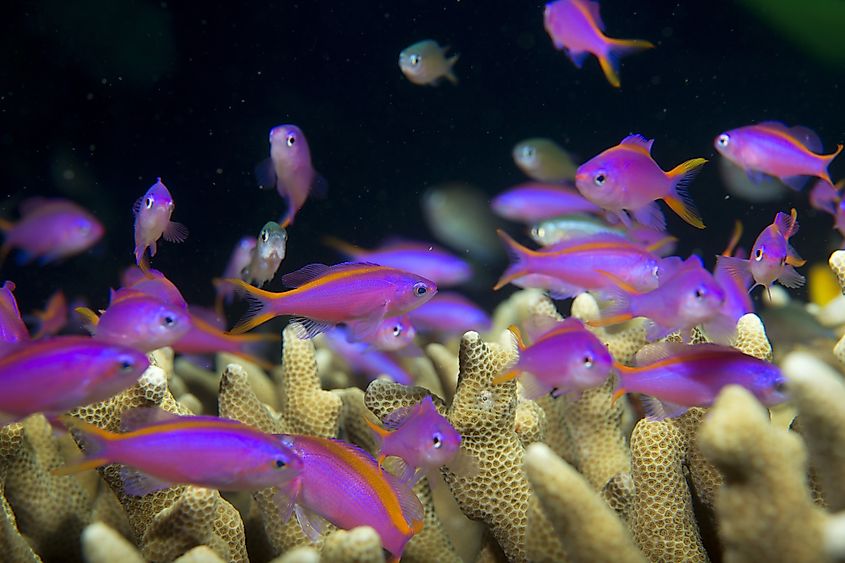
The Philippines is surrounded by about 25,060 km2 of coral reefs, making it the third-largest reef nation. Its reef area is half the Indonesian reef area and accounts for about 8.81% of the global coral reef area. These reefs are beneficial to the country in several ways, including protecting the communities from hurricane and typhoons, as well as providing a rich fishing ground and promoting tourism.
Apo Reef, located in the Mindoro Strait, is the Philippine’s largest reef system. It covers 34 km2 has been included in UNESCO’s alternative list of World Heritage Sites. Another prominent reef system in the Philippines is the Tubbahata Reef in the Sulu Sea. It is the world’s most pristine and species richest reef, and has been designated World Heritage Site. Besides the two reefs, numerous fringing reefs are found around Babuyan and Batanes Islands and off the Visayas’ coast.
One of the major threats to coral reefs in the Philippines is bleaching. Bleaching is a process of expelling photosynthetic algae from coral polyps. Thus, corals do not get nutrients and also lose their pigments. Coral reefs in Visayas, Palawan, and Luzon have suffered the most from bleaching. Besides bleaching, dangerous fishing methods like blast fishing have put coral reefs in the Philippines in great danger.
France
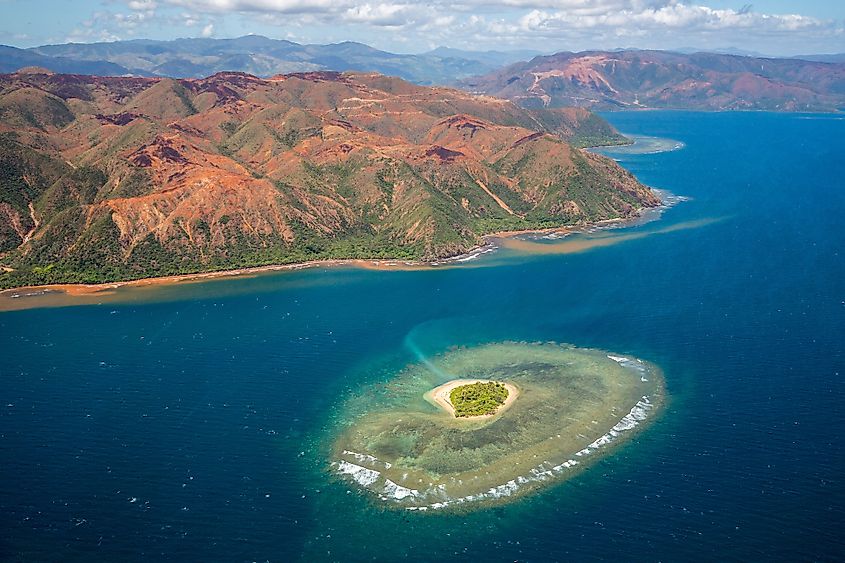
In France, coral reefs mainly border its territories, such as French Guiana, Guadeloupe, Clipperton, French Polynesia, and New Caledonia. It has a reef area of about 14,280 km2, accounting for 5.02% of the global reef area. Almost all the 118 French Polynesian islands have fringing reefs around them. Some of these reefs and atolls have been used for research programs, including demonstrating how an atoll reef forms. Some of the well-studied atolls and reefs are the Tahiti, Tikehau, and Mataiva.
France also possesses part of the Amazonian Reef. This reef is shared by French Guiana, France’s overseas region, and Brazil. It is located off French Guiana’s coast and extends to northern Brazil. With a size of approximately 9,300 km2, the Amazon Reef is one of the world’s largest coral reefs.
Major environmental threats to French coral reefs are overfishing, pollution, and increased ocean acidification. Pollution from oil exploration is considered a major threat to the Amazon Reef
Other Countries with Large Coral Reef Area
Apart from Indonesia, Australia, the Philippines, and France, other countries with significantly large reef areas are Papua New Guinea (13,840 sq. km), Fiji (10,020 sq. km), Maldives (8,920 sq. km), Saudi Arabia (6,660 sq. km), Marshall Islands (6,110 sq. km), and India (5,790 sq. km). The United States has the 16th largest reef area (3,770 sq. km), accounting for 1.33% of the global reef area.
Countries By Coral Reef Area
| Rank | Country | Reef Area (km2) | % of world total |
|---|---|---|---|
| 1 | Indonesia | 51,020 | 17.95% |
| 2 | Australia | 48,960 | 17.22% |
| 3 | Philippines | 25,060 | 8.81% |
| 4 | France | 14,280 | 5.02% |
| 5 | Papua New Guinea | 13,840 | 4.87% |
| 6 | Fiji | 10,020 | 3.52% |
| 7 | Maldives | 8,920 | 3.14% |
| 8 | Saudi Arabia | 6,660 | 2.34% |
| 9 | Marshall Islands | 6,110 | 2.15% |
| 10 | India | 5,790 | 2.04% |
| 11 | Solomon Islands | 5,750 | 2.02% |
| 12 | United Kingdom | 5,510 | 1.94% |
| 13 | Micronesia, Federated States of | 4,340 | 1.53% |
| 14 | Vanuatu | 4,110 | 1.45% |
| 15 | Egypt | 3,800 | 1.34% |
| 16 | United States of America | 3,770 | 1.33% |
| 17 | Malaysia | 3,600 | 1.27% |
| 18 | Tanzania | 3,580 | 1.26% |
| 19 | Eritrea | 3,260 | 1.15% |
| 20 | Bahamas | 3,150 | 1.11% |
| 21 | Cuba | 3,020 | 1.06% |
| 22 | Kiribati | 2,940 | 1.03% |
| 23 | Japan | 2,900 | 1.02% |
| 24 | Sudan | 2,720 | 0.96% |
| 25 | Madagascar | 2,230 | 0.78% |
| 26 | Thailand | 2,130 | 0.75% |
| 27 | Myanmar | 1,870 | 0.66% |
| 28 | Mozambique | 1,860 | 0.65% |
| 29 | Mexico | 1,780 | 0.63% |
| 30 | Seychelles | 1,690 | 0.59% |
| 31 | China | 1,510 | 0.53% |
| 32 | Tonga | 1,500 | 0.53% |
| 33 | Belize | 1,330 | 0.47% |
| 34 | New Zealand | 1,310 | 0.46% |
| 35 | Vietnam | 1,270 | 0.45% |
| 36 | Jamaica | 1,240 | 0.44% |
| 37 | Brazil | 1,200 | 0.42% |
| 38 | United Arab Emirates | 1,190 | 0.42% |
| 39 | Palau | 1,150 | 0.40% |
| 40 | Costa Rica | 970 | 0.34% |
| 41 | Colombia | 940 | 0.33% |
| 42 | Taiwan | 940 | 0.33% |
| 43 | Mauritius | 870 | 0.31% |
| 44 | Honduras | 810 | 0.28% |
| 45 | Panama | 720 | 0.25% |
| 46 | Nicaragua | 710 | 0.25% |
| 47 | Somalia | 710 | 0.25% |
| 48 | Tuvalu | 710 | 0.25% |
| 49 | Iran | 700 | 0.25% |
| 50 | Qatar | 700 | 0.25% |
| 51 | Yemen | 700 | 0.25% |
| 52 | Sri Lanka | 680 | 0.24% |
| 53 | Kenya | 630 | 0.22% |
| 54 | Dominican Republic | 610 | 0.21% |
| 55 | Bahrain | 570 | 0.20% |
| 56 | Oman | 530 | 0.19% |
| 57 | Samoa | 490 | 0.17% |
| 58 | Venezuela | 480 | 0.17% |
| 59 | Netherlands | 470 | 0.17% |
| 60 | Djibouti | 450 | 0.16% |
| 61 | Haiti | 450 | 0.16% |
| 62 | Comoros | 430 | 0.15% |
| 63 | Antigua and Barbuda | 240 | 0.08% |
| 64 | Brunei Darussalam | 210 | 0.07% |
| 65 | Saint Kitts and Nevis | 180 | 0.06% |
| 66 | Saint Lucia | 160 | 0.06% |
| 67 | Grenada | 150 | 0.05% |
| 68 | Saint Vincent and the Grenadines | 140 | 0.05% |
| 69 | Kuwait | 110 | 0.04% |
| 70 | Barbados | <100 | |
| 71 | Dominica | <100 | |
| 72 | Singapore | <100 | |
| 73 | Trinidad and Tobago | <100 | |
| 74 | Bangladesh | <50 | |
| 75 | Cambodia | <50 | |
| 76 | Ecuador | <50 | |
| 77 | Jordan | <50 | |
| 78 | Nauru | <50 | |
| 79 | Israel | <10 |











